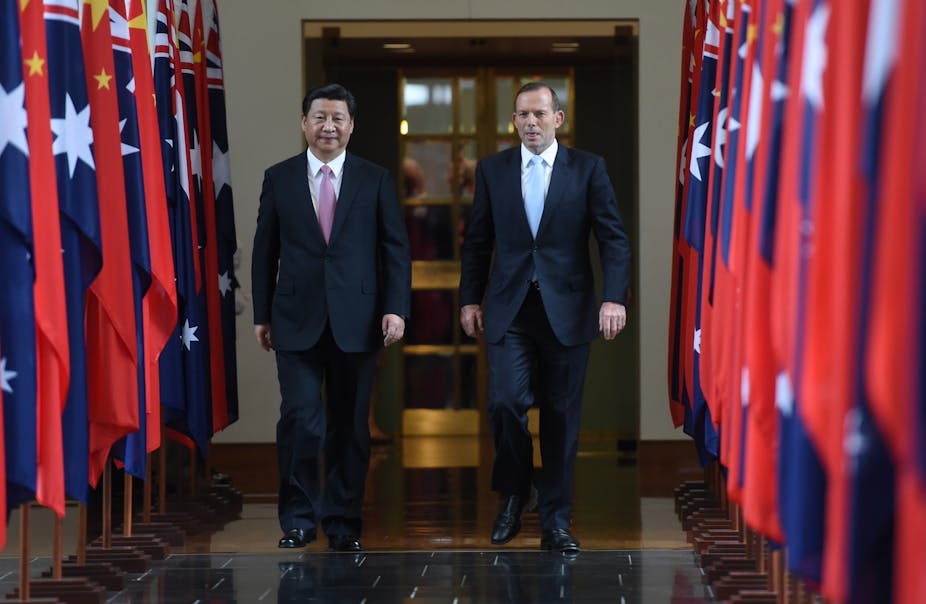During the APEC meeting in Beijing, President Xi Jinping announced China will spend US$10 trillion on imports over the next five years and US$1.25 trillion in foreign investment over the next ten years. While these are very large figures, they do not amount to much of an annual increase over current volumes. Instead, they signal China’s long-term commitment to further globalisation.
The China-Australia Free Trade Agreement is a game changer in more ways than one. It improves the business outlook for Australian exporters. It also dismisses concerns that Australia’s relations with its traditional allies have alienated China and harmed economic relations.
Australian goods and services are now supported by invigorated business links to China and better access to global markets. If Australia maintains its share of Chinese total imports and outbound direct investment, China will be Australia’s major trade and investment partner for the next decade at least. Expectations are that mutual self-interest will continue to pull Australia closer to China.
From a business perspective, the pull effect has been operational during most of the mining boom. This really was a China boom, driven by the large demand from China for Australian resources.
The agreement ensures trade will increase by billions of dollars. China has been Australia’s biggest trading partner since 2009. In 2013, Australia’s two-way trade with China surpassed $150 billion.
The main winners will be Australian agriculture, service industries, resources and certain manufacturing industries. Tariff reductions across the board will create new opportunities for Australian businesses and increase their competitive advantages in the Chinese market. Chinese consumers and producers will also get better access to Australian agribusiness products, new financial services and manufacturing products.
Beyond the FTA
This new China boom will pull Australia into the Chinese business orbit, but it will take significant effort on the Australian side to break into Chinese consumer and producer markets. The much-quoted “dining boom” will require deeper integration with Chinese businesses across different industries and involve risks.
In many areas covered by the agreement, Australian businesses and their Chinese partners face a “liability of newness”. This will be particularly apparent in markets that are newly open to Australia including wealth management, insurance and private health care.
The Chinese market is highly fragmented and fiercely competitive. For example, China’s dairy supply chain is long and complex with many parties involved. To overcome supply chain constraints, agribusiness companies such as New Zealand dairy co-operative Fonterra have chosen to partner with Chinese food manufacturers.
Australian business are now investing in supply chains that stretch from the Australian countryside to Chinese consumers in second and third-tier cities. This investment requires new infrastructure at both ends to convert lower tariffs into better consumer prices. This could mean a new way of economic engagement between Australian and Chinese businesses.
Previously, Australia-China trade was characterised by large resource deals with a small number of multinational corporations. Increasingly, we will see an increasing number of smaller deals involving many more parties. These deals will require a more sophisticated understanding of the Chinese market and closer coordination with Chinese partners.
In the services sector, the ground for new markets and products has only been established by recent reforms. Xi initiated these with his deregulation agenda during the Third Plenum in November 2013. Australian providers will be among the first to trial these new policies.
If experience from previous reforms is anything to go by, early movers will reap huge benefits. However, as Chinese domestic competitors increase in number and sophistication, they will also exert pressure on Australian service providers. For example, the increasingly globalised Chinese banks are undergoing rapid reform to improve their performance and competitiveness.
Australian manufacturers will need to invest time and effort to build personal relationships and inter-organisational trust. Results from a recent Australia China Business Council survey show that on average Australian businesses spent around 12 months researching the China market before entry. Building effective personal relationships and inter-organisational trust can take much longer than that. These manufacturers will be keen to enter Chinese domestic supply chains and through their Chinese contacts gain access to global value chains.
Chinese direct investments in Australia will increasingly play a bridging role between businesses on both sides. The easing of investment approvals for Chinese private investors is important. It will enable smaller Chinese investors who are closer to their domestic consumer market to partner Australian business seeking access to consumers and supply chains. The lifting of the investment threshold to $1.1 billion for private investors will mean increasing numbers of Chinese businesses enter Australia to invest.

